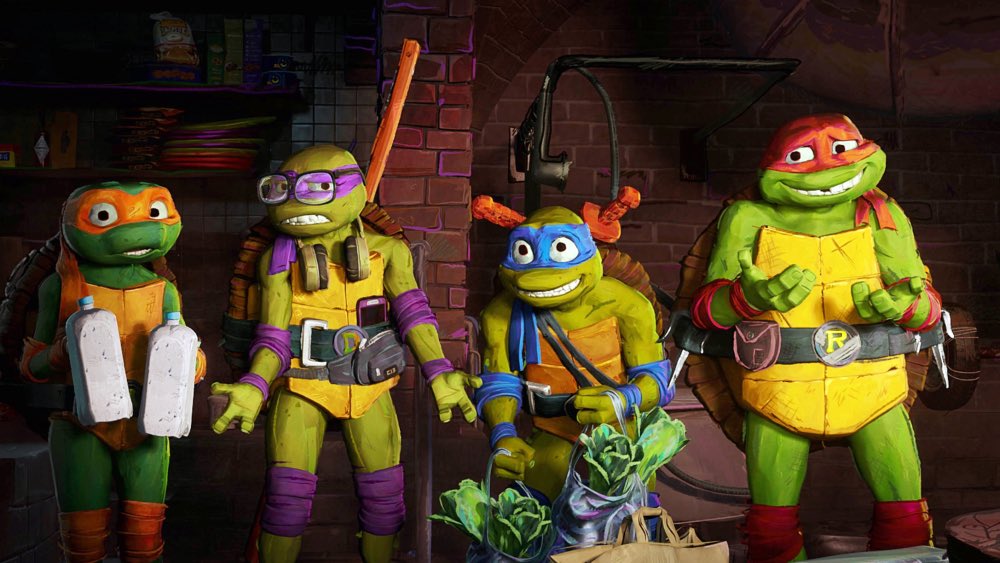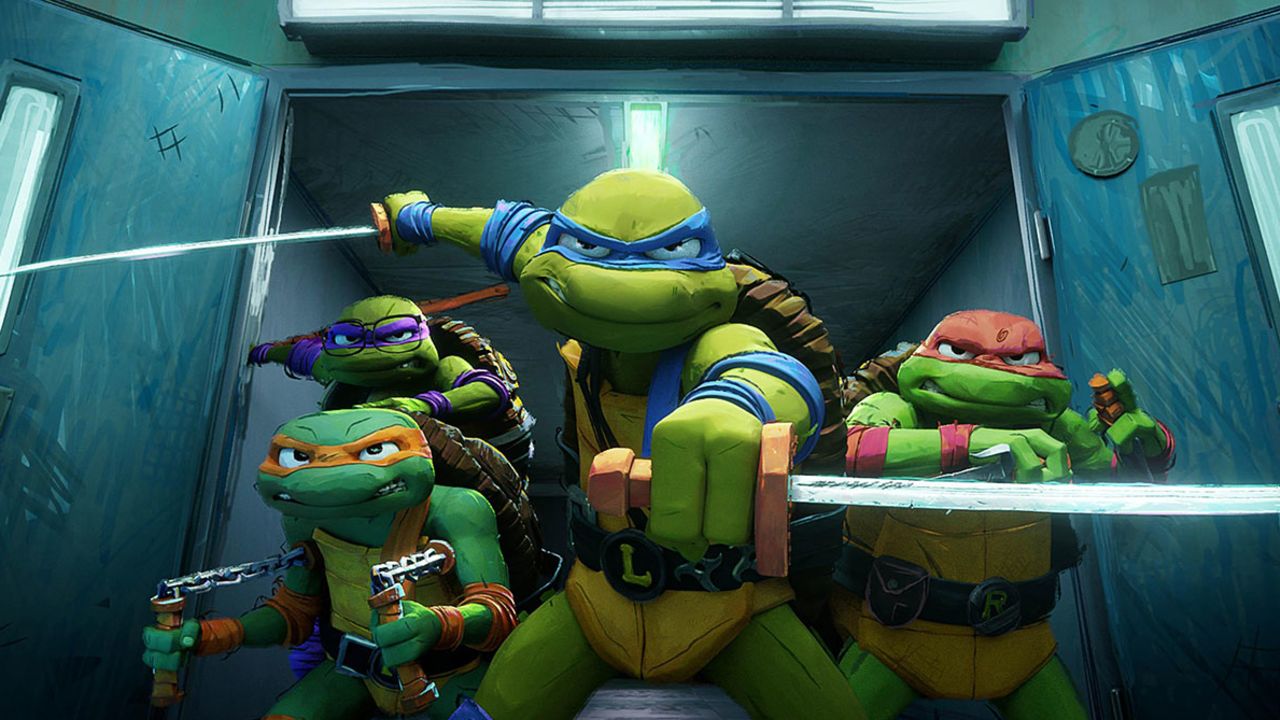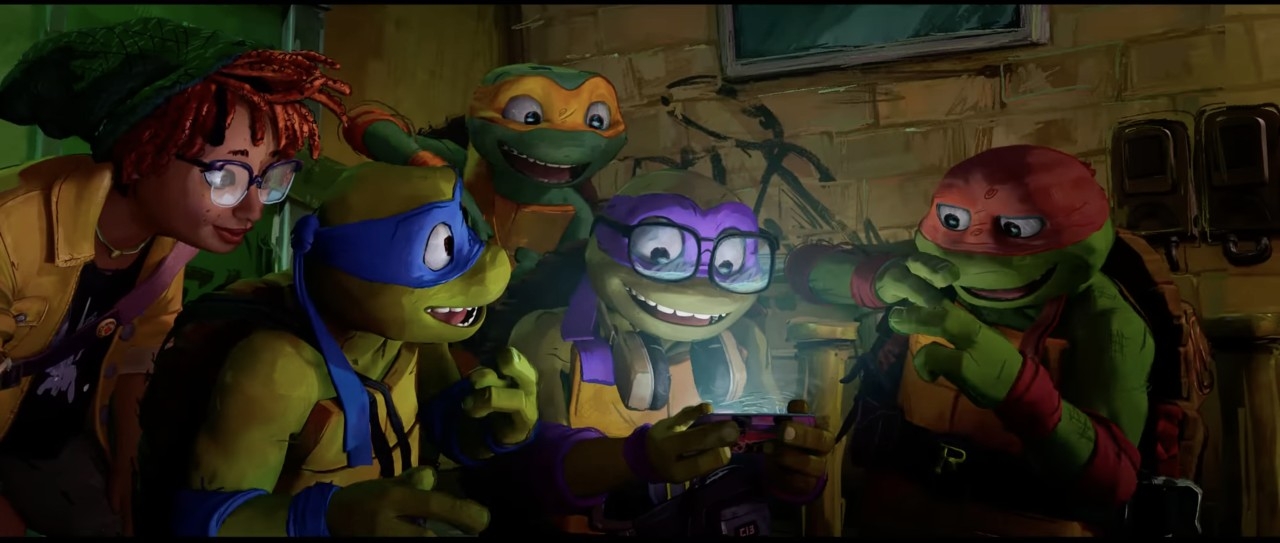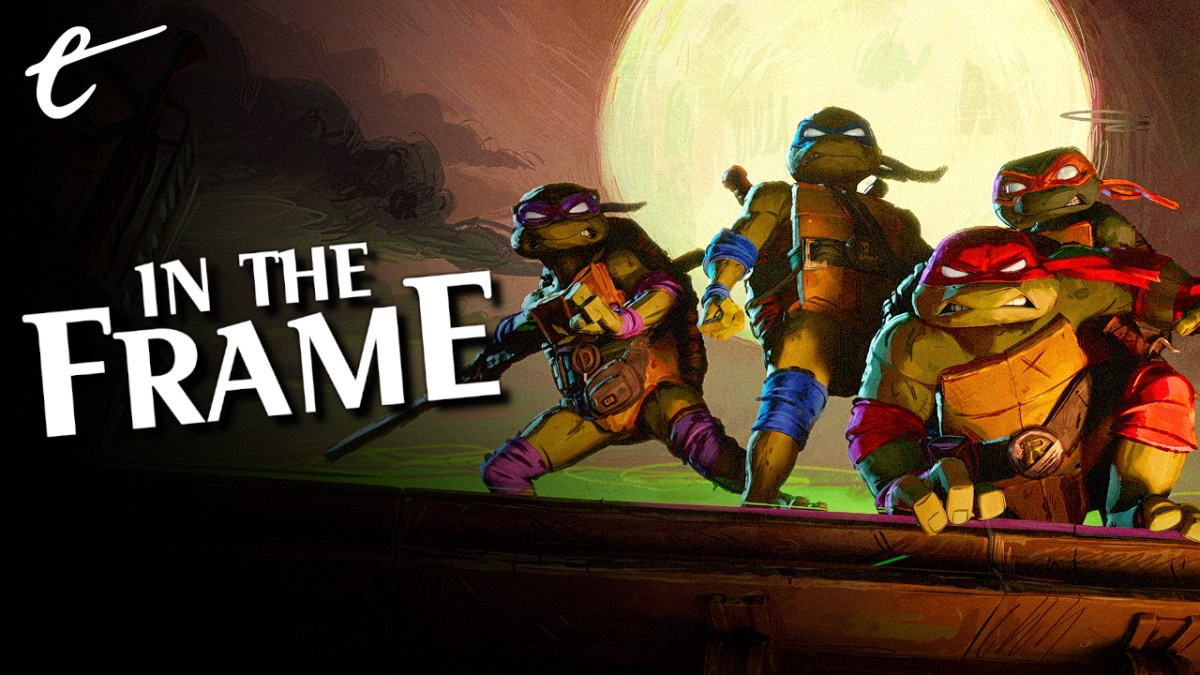Teenage Mutant Ninja Turtles (TMNT) began as an affectionate parody of Marvel Comics. Specifically, Kevin Eastman and Peter Laird conceived the comic as a riff on Frank Miller’s era-defining run on Daredevil.
The references are quite obvious. Matt Murdock becomes Daredevil when he is exposed to radioactive liquid while saving a blind man from an oncoming truck, and the Turtles are mutated when exposed to ooze from a similar accident. Miller created a blind mentor character named “Stick,” so the Turtles got their own teacher named “Splinter.” Daredevil battled a cult of evil ninjas named the Hand, so the Turtles took on the Foot Clan.
This shared history tends to get overlooked. Indeed, there’s a solid argument to be made that Teenage Mutant Ninja Turtles have ironically eclipsed Daredevil in the public imagination. Still, this origin story is perhaps the key to understanding Teenage Mutant Ninja Turtles: Mutant Mayhem, the most recent cinematic adaptation of the heroes in a half-shell. These are superheroes, but they belong to a very particular lineage of superheroes.
Traditionally, teenage characters appeared in comic books as sidekicks, audience identification characters for the target demographic. Many of these sidekicks continue to the present day, although many have graduated to become heroes in their own right. Still, it was an obvious trend: Batman had Robin, Captain America had Bucky, Green Arrow had Speedy, Blue Beetle had Sparky. In the genre’s early days, superheroism was something that teenagers could only do under adult supervision.
During the 1960s, one of Stan Lee’s big innovations was the idea that teenage readers didn’t want to see themselves as companions or hangers-on, but wanted to be the heroes of these stories. Lee’s ambivalence towards teenage sidekicks played out in a number of ways. For example, he famously killed off Bucky when dragging Captain America into the shared universe and as editor-in-chief he oversaw the death of Toro, the teenage sidekick of the original Human Torch.

However, Lee’s biggest innovation was in figuring out that it was possible for teenagers to be the lead characters in these superhero soap operas without being relegated to the role of sidekick. Spider-Man was a game changer, the secret identity of mild-mannered teenager Peter Parker who found himself dealing with all the pressures of adolescence on top of the sorts of high-stakes adventures facing the protagonists of these stories.
“I hated teenagers in comics because they were always sidekicks,” Lee would explain of his approach years later. “But I thought it might be interesting to make the teenager the actual hero. What would happen if a teenage kid got a power?” This was a radical concept, and it caught on fast. Working with Jack Kirby, Lee would also create X-Men, a comic about a bunch of teenagers studying at an elite private school that were also mutant superheroes fighting to save the world.
It is easy to understand why these sorts of stories resonate with teenagers. On a superficial level, puberty finds the human body changing and developing in strange ways. Superpowers are just a heightened version of that, reflecting how it can feel. More than that, with hormones raging and no real life experience, the mundane pressures of everyday life can feel existential to teenagers. Being liked by one’s peer group can seem just as high-stakes as saving the world from an evil octopus man.
There is even the idea of the secret identity. This metaphor obviously has a very deep and emotional appeal to people who discover facets of themselves during their teenage years, as teenagers grapple with their sexual orientation or their gender identity. On a broader level, adolescence marks the point at which many kids start to truly form their own separate and distinct identities separate from their parents or their families. As such, the superhero archetype has a resonance for teens.
TMNT: Mutant Mayhem works as well as it does because it understands this. Mutant Mayhem is a superhero film. Indeed, the basic plot of the movie hinges on an evil scheme lifted directly from Bryan Singer’s X-Men, where the villainous Magneto (Ian McKellen) threatens to deploy a machine that will turn all life on the planet into mutants. In Mutant Mayhem, the monstrous Superfly (Ice Cube) is planning something similar, albeit aimed at wildlife not humanity.
However, Mutant Mayhem approaches this plot through the archetype of the classic “coming-of-age” narrative. Early in the movie, Leonardo (Nicolas Cantu), Donatello (Micah Abbey), Michelangelo (Shamon Brown Jr.) and Raphael (Brady Noon) sneak away while conducting a grocery run for Splinter (Jackie Chan), taking the opportunity to catch a public screening of Ferris Bueller’s Day Off in Brooklyn. It’s a reference that immediately anchors TMNT: Mutant Mayhem in the tradition of teen cinema.

Indeed, Mutant Mayhem’s frame of reference is largely drawn from movies that would have been foundational for a modern teenage audience. The characters casually drop references to millennial animated features like MegaMind, Despicable Me, and Ratatouille, or television shows like Attack on Titan. The assumption seems to be that the movie’s target demographic will be more familiar with those movies than established Teenage Mutant Ninja Turtles lore.
The publicity for TMNT: Mutant Mayhem leaned heavily on the fact that the film was “from permanent teenager Seth Rogen.” Rogen not only provides the voice of Bebop, but is also credited on the screenplay alongside writing and producing partner Evan Goldberg. Rogen and Goldberg’s first feature film screenplay credit was on the coming-of-age classic Superbad, with Rogen recently joking that nobody has “made a good high school movie since then.”
To their credit, Goldberg and Rogen have done their bit to keep the coming-of-age comedy alive, producing both Blockers and Good Boys. However, both have openly talked about the challenges facing the genre. Rogen has discussed how difficult it is for comedy films to compete with a blockbuster superhero genre that has embraced comedy. Goldberg has argued that for a modern comedy to succeed, it needs an x-factor, something to make it stand out from the crowd.
TMNT: Mutant Mayhem works by wedding that teenage coming-of-age comedy to the most dominant genre in contemporary blockbuster filmmaking. In doing so, it takes the superhero movie back to that Stan Lee innovation. Mutant Mayhem is, at its core, a film about what it is like to be a teenager and to want desperately to fit in. The word “acceptance” is repeated countless times in the screenplay. The only word that appears more frequently may be “milk,” in one of the film’s best recurring gags.
Desperate to escape the sewers and live with humans who inhabit New York, the Turtles concoct an elaborate plan. Hearing that Superfly has been stealing scientific equipment, the teenagers come to believe that they will win acceptance from the city’s general population if they can recover the stolen merchandise and bring the villain to justice. In Mutant Mayhem, the superheroism is just a means to the most teenage ends imaginable: the hope that one might be seen and embraced by one’s peers.

Everything in Mutant Mayhem is filtered through this prism. Superfly, a literal mutated housefly, is just as much an outcast teenager as the Turtles. He was created by the scientist Baxter Stockman (Giancarlo Esposito). However, Stockman was killed when his lab was raided, and Superfly was forced to go into hiding. Like Splinter, Superfly has grown suspicious and resentful of the human world. Unlike the Turtles, Superfly believes that humanity will never truly accept him or his fellow mutants.
This is a nice dramatic hook for the film, and it marks a welcome departure from the overuse of Shredder as the series’ default antagonist. (Naturally, the film’s final shot is a post credits scene teasing the arrival of “the Shredder” in the sequel.) More than that, it positions the Turtles and Superfly at opposite ends of the teenage spectrum. They are all insecure and alienated, but Superfly has allowed his feelings of isolation to metastasize into violent and destructive rage.
While TMNT: Mutant Mayhem inevitably builds to the sort of explosive spectacle demanded from a superhero blockbuster, the movie works best in its quieter moments. It’s fun to watch the Turtles play at being teenagers, filming each other testing out their weapons. The film’s best performance comes from Jackie Chan as Splinter, the father figure desperately trying to both protect and understand his children. The film has a lot of heart, and it wears it on its sleeve.
This also plays into the film’s visual storytelling. Production designer Yashar Kassai has talked about the movie’s “design philosophy” being rooted in the aesthetic of a teenager’s sketch book: “draw like you’re 15,” “be emo and cringe,” and even “draw very serious things but add levity by drawing them shitty.” Director Jeff Rowe has talked about wanting the film to look “sketchy and imperfect and misshapen and reminiscent of the way you draw when you’re a child or a teenager.”
Teenage Mutant Ninja Turtles: Mutant Mayhem is a superhero origin story unashamed of its adolescent sensibility. It’s a film that understands why the genre has spoken so strongly to generations of teenagers. That is perhaps the real Turtle power.






Published: Aug 4, 2023 11:00 am